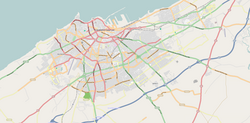
Back مقاطعة الحي المحمدي Arabic Hay Mohammadi Catalan Hay Mohammadi CEB حی محمدی Persian Hay Mohammadi Swedish
Hay Mohammadi
الحي المحمدي | |
|---|---|
Arrondissement of Casablanca | |
| Coordinates: 33°35′13″N 7°32′39″W / 33.58694°N 7.54417°W | |
| Country | |
| Region | Casablanca-Settat |
| Prefecture | Casablanca |
| Population (2004) | |
| • Total | 156,501 |
| Time zone | UTC+0 (WET) |
| • Summer (DST) | UTC+1 (WEST) |
Hay Mohammadi or Hay Mohammedi (Arabic: الحي المحمدي) is a neighbourhood in eastern Casablanca, in the Aïn Sebaâ - Hay Mohammadi district of the Casablanca-Settat region of Morocco. As of 2004 it had 156,501 inhabitants.[1]
The district was once home to North Africa's oldest and largest slum, formerly known as Carrières Centrales, which was largely demolished throughout the 2010s within the framework of the Moroccan government's 'Cities without Slums' (French: Villes sans bidonvilles; Arabic: مدن بلا أحياء فقيرة).[2] The project has been criticized for its forced relocation into unsustainable debts and relocating city dwellers away from their work and social sphere.[2][3] Celebrated as a laboratory for industrial and housing innovation during the colonial period, but also famous for playing a crucial role in the anticolonial struggle, according to Strava, C. (2021).[4]
This neighbourhood has been historically referred to as a 'mythical place', and locals talk about it with pride and affection.[2]
The people in Hay Mohammadi face various challenges, including social degradation, economic insecurity, and struggles for material well-being. These issues are exacerbated by urban transformations, historical legacies, and neoliberal reforms that impact their everyday lives. Additionally, residents grapple with inadequate housing conditions, limited access to resources, and the reproduction of social inequalities within the neighborhood.[5]
- ^ "Recensement général de la population et de l'habitat de 2004" (PDF). Haut-commissariat au Plan, Lavieeco.com. Retrieved 22 April 2012.
- ^ a b c Strava, Cristiana (2022). Precarious modernities : assembling state, space and society on the urban margins in Morocco. London, UK. ISBN 978-1-350-23257-0. OCLC 1256588608.
{{cite book}}: CS1 maint: location missing publisher (link) - ^ Bogaert, Koenraad (2013-09-02). "Contextualizing the Arab Revolts: The Politics behind Three Decades of Neoliberalism in the Arab World". Middle East Critique. 22 (3): 213–234. doi:10.1080/19436149.2013.814945. ISSN 1943-6149. S2CID 144684360.
- ^ Precarious modernities : assembling state, space and society on the urban margins in Morocco (First edition.). Zed Books. https://doi.org/10.5040/9781350232570
- ^ Strava, Cristiana (2021). Precarious Modernities. New York: Bloomsbury. pp. 1–27. ISBN 978-1-350-23257-0.
